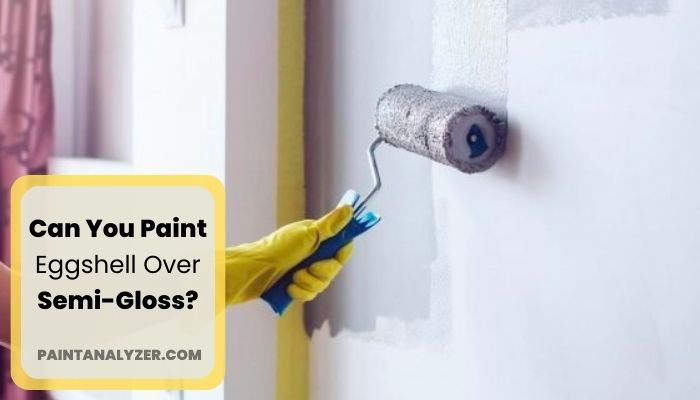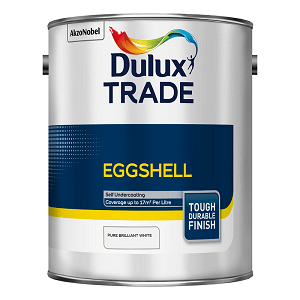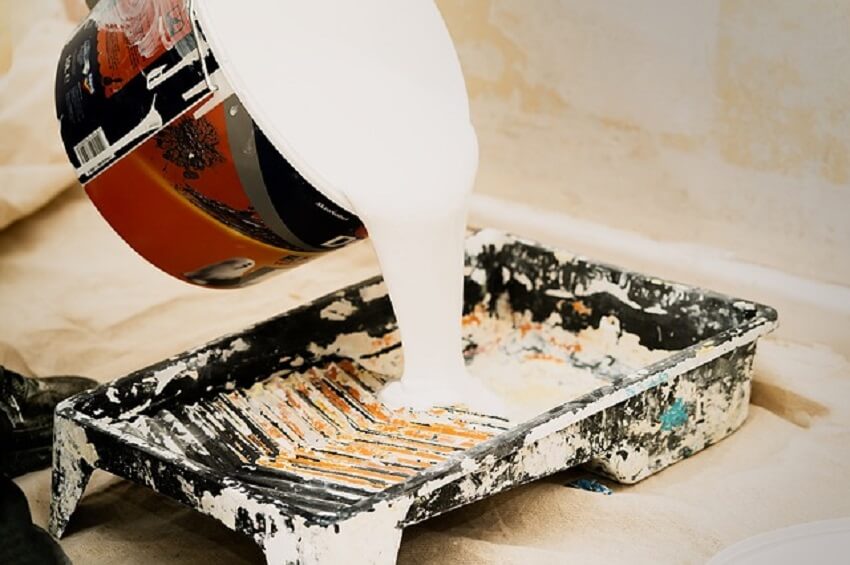Planning on giving your home a new look? Or perhaps changing the furniture finish to keep up with the newest trend?
Whatever your reason might be, trying a new look is always fun and exciting to do! And what better way to do this other than changing the room color?
But what if your walls are already painted? Don’t worry, in this case, you can just repaint the whole thing, and believe me, it’s quite easy!

But can you paint Eggshell over semi gloss?
In short, yes you can. The broad surface coverage of the Eggshell paint makes it easier to stick to most surfaces. Its finish won’t be as smooth as semi gloss, but where it loses gloss, it makes up for sturdiness.
Eggshell paint can be applied on almost any exterior; the only difference is the preparations you might need before painting.
Why You Should Consider Painting Eggshell Over Semi Gloss?
While painting your home, the most important thing you should keep in mind is what type of paint to use. You might find several different choices, but not all paints are well-suited for your project.
This is where eggshell comes in, it’s attractive, and one size fits all paint sheen that brings out the most of your work.
Let’s go over 6 reasons for you to consider using eggshell:

● Adhesion Properties
This paint has a great deal of adhesion, making it a great choice for painting over smooth surfaces.
Semi gloss paints have a lot of moisture resistance capability, and that makes it hard for normal paints to stick to the surface. But, due to the eggshell’s impressive bonding power and good surface coverage, this can easily be painted over glossier finishes.
● Easy on Your Pocket
Let’s face it, new paint jobs, even when repainting, can turn out to be quite costly. But for eggshell paint, this won’t be a problem. Compared to other paint types in the market, eggshell offers a significantly reasonable price. So, painting Eggshell over semi-gloss won’t be a financial nightmare.
Eggshell paint is between four and five percent less expensive than its counterparts.
● Sturdy Performance
The phrase “Eggshell” might be deceitful to some folks, although, unlike actual eggshells, this is not weak. It is pretty durable to the process of erosion, making it an excellent choice for high-traffic areas i.e. bathrooms, kitchens, and kids’ rooms.
At the same time, this is a great choice if you desire your finish to hit the sweet spot. It’s neither too shiny nor too matte-like. All in all, decor experts highly recommend using Eggshell.
● Easy to Use
If you have painted before, you have surely come across the lapping problem, and for those of you who don’t know, lapping occurs when bordering lines of paint start to overlay each other. The glossier the paint, the more it is likely to overlap.
Luckily, the eggshell paint is coarse and does not make the lapping apparent. And this means time is not an issue while using this. You can sit back, enjoy some tea, and get back to working again without having to worry about lines showing up.
● Flaw Concealment
Higher reflectivity on smooth sheen makes the little nicks and bumps on walls noticeable. The greater the gloss, the easier it is to spot even the tiniest imperfection. Grittier or flat paints are better at hiding small bumps, cracks, grooves, and pitting.
This is where Eggshell excels; its semi matte finish helps to hide impurities. What’s more, because of its great durability, it holds up against daily damage effectively.
● Easy Cleaning
Do you like hosting parties or love to have kids running around your house? If so, then your walls are sure up for some beating.
Jokes aside, glossy paints are easy to clean. On the contrary, flat paints can give you a nightmare while cleaning the surface. But Eggshell has just enough sheen to prevent stains or marks from soaking in.
Also, you might face burnishing problems with most matte paints when cleaned harshly. Eggshell gloss prevents this from happening.
Can You Use Eggshell Over Eggshell?
Eggshell paint sits in between the lines of being glossy and matte.
It’s not too glossy but enough to cause adhesion issues. With that being said, you can paint over an eggshell if it’s a freshly painted surface.
But if the paint has dried already, or you’re trying to paint over an old surface (woodwork, old wall, etc.), painting can be tough. In this case, you can simply sand the surface to remove some sheen or use a de-glossing agent.
How to Paint Eggshell over Semi Gloss?

Now that we know the essentials, let’s get over the steps on How to Paint Eggshell over semi gloss:
Step 1 – Tidying the Room
Before we begin, we need to clear the room up a bit; this will make movement easier and prevent unwanted spill marks.
Kick-off by taking any painting, artwork, or curtains off of your walls. Next, move the sofa, and tea tables from the room being painted.
Then, use painter’s tape to cover the baseboards, windows, and door frames. This way, you can easily avoid unwanted cleaning afterward.
Don’t forget to cover the floors with a drop cloth; we don’t want any spills, do we?
Step 2 – Preparing the Surface
The secret to an outstanding paint finish lies in preparation; the better you prepare the surface, the better results you will get. To achieve a good finish we have to follow some simple steps —
● Washing
Cleaning the surface is an integral step before repainting; this helps to dispose of any wanted dirt or debris that could reduce the adhesive qualities of your paint. You can start the cleaning process by wiping the wall with a damp cloth.
Thoroughly clean the walls to reveal any trivial defects that might require attention. Fix any small holes or cracks with a spackling compound. Let it dry off thoroughly before moving on to the next step.
Note that for high-humidity areas, like the kitchen or washroom, we advise you to clean the surface with TSP (tri-sodium phosphate).
Related: How to Dispose of Acrylic Paint?
● Sand the Wall
Smooth sheen paints are recognized for their humidity protection, this makes painting harder to stick to the surface.
We can easily avoid this issue by lightly sanding the walls with a pole sander and 150-grit sandpaper. This will give the surface a bit of rough character making it easier for the paint to bond, as well as removing any loose particles.
● Priming the Surface
We highly urge you to use a layer of priming agent before painting. This provides a good anchor layer for the paint. You could dodge this by diluting 20 percent water in your paint, then using it as a substitute for primer.
Step 3 – Start Painting
You’re groomed to use your eggshell paint. Open the bucket, and blend gently for 2-3 minutes using a stir stick.
Now, put a generous amount on your tray, and paint along the edges using a brush. After that, paint the ceiling using a roller. Let the paint dry, and then proceed to paint the walls.
Begin from the upper portion, and make your way down the base.
Remember to roll slowly to avoid roller marks. Inspect using proper lighting. If you notice uneven ridges, sheens, or bumps, try putting on a second layer.
Tips before Painting
Here are some tips that will help you achieve a professional finish –
Tip 1- Paint Consistency
Before painting, be sure to thin your paint using turpentine, water, or medium acetone. Uneven paint mixtures tend to leave roller marks.
To dodge this, dilute the paint properly.
- While using water or acrylic-based eggshell paint, use 10 percent cold water to thin.
- When using oil-based color, use turpentine or acetone mixture in a 1:4 ratio of thinning agent to paint.
Not having the right paint consistency will cause your paint to dry, form bubbles or crack, and chip away.
Related: Will Acetone Damage Car Paint?
Tip 2 – Selecting the Right Roller
There are tons of paint rollers varying in sizes, textures, naps, and materials.
Therefore, each of these has its unique uses. A roller with wool fiber and a 3/8 inch nap would be the most suitable for your work.
However, you can also use a ½-inch nap roller. Just make sure to apply them evenly and avoid overlapping lines.
Tip 3 – Use the Right Pattern
Unlike flatter paint sheen, you cannot roll eggshell paint in any direction.
You should strictly paint in one fixated direction, horizontally, diagonally, or vertically. Avoid backing the roller after finishing a single coat. Also, don’t stop your roller halfway.
Tip 4 – Proper Ventilation
Be sure to open any windows in the room to allow enough air to come in. This will avoid any uneven drying and unnecessary moisture buildup.
Is Sanding Important?
Honestly, yes, you need to sand smooth surfaces before putting on new paint. The semi gloss paint’s moisture resistance is good for avoiding stains but creates problems while repainting. Sanding generally solves the problem.
But if you want to skip the sanding hassle altogether, you can just use de-glossing chemicals. However, we highly recommend sanding the surface.
Is it Possible to Paint Eggshell Over Semi-Gloss Without Sanding?
Yes, it is possible to paint over semi-gloss without sanding if using the right techniques and products. Using a good quality primer designed to paint over semi gloss can help the new eggshell paint adhere to the surface properly without the need for sanding.
Is it possible to paint a kayak with different types of paint, such as eggshell or semi-gloss?
Yes, it is possible to paint a kayak with different types of paint, such as eggshell or semi-gloss. However, it is important to properly prepare the surface and use marine-grade paint to ensure durability. Additionally, consider using a primer specifically designed for plastic surfaces. Follow these painting a kayak tips for best results.
Is Using Primer Important?
Primers are typically designed to increase the adhesiveness of the surface, namely smooth ones.
Applying primer will significantly enhance the bonding capabilities of your eggshell paint, thus making it less likely to chip away.
Tips for Buying the Right Paint
The quality of paint, regardless of the type, determines the finished result of your paintwork.
We advise you to go for a reputable paint brand. Also, consistency may vary from brand to brand. So, it’s always a good idea to ask for samples to see whether the paint meets your requirements or not.
Choosing the right paint could be tricky, but with some thorough research, you can pick the right paint.
Conclusion
Now that you know the aesthetic quality and sturdiness of Eggshell paint, it’s time to roll up your sleeves, put on your overalls, and start painting.
Cleaning is much easier with eggshells than with other flat paints, although you may lose some shine, what it loses in shine makes up for longevity. No matter what type of paint you use, try to have fun and enjoy the process.
The key to a good finish is to know how to apply paint properly by taking the appropriate approach.
In this article, we went through the basics of painting, how can you paint Eggshell over semi gloss, and some tips on how you can improve your finish. We hope you found this article helpful, and good luck with your endeavor!
